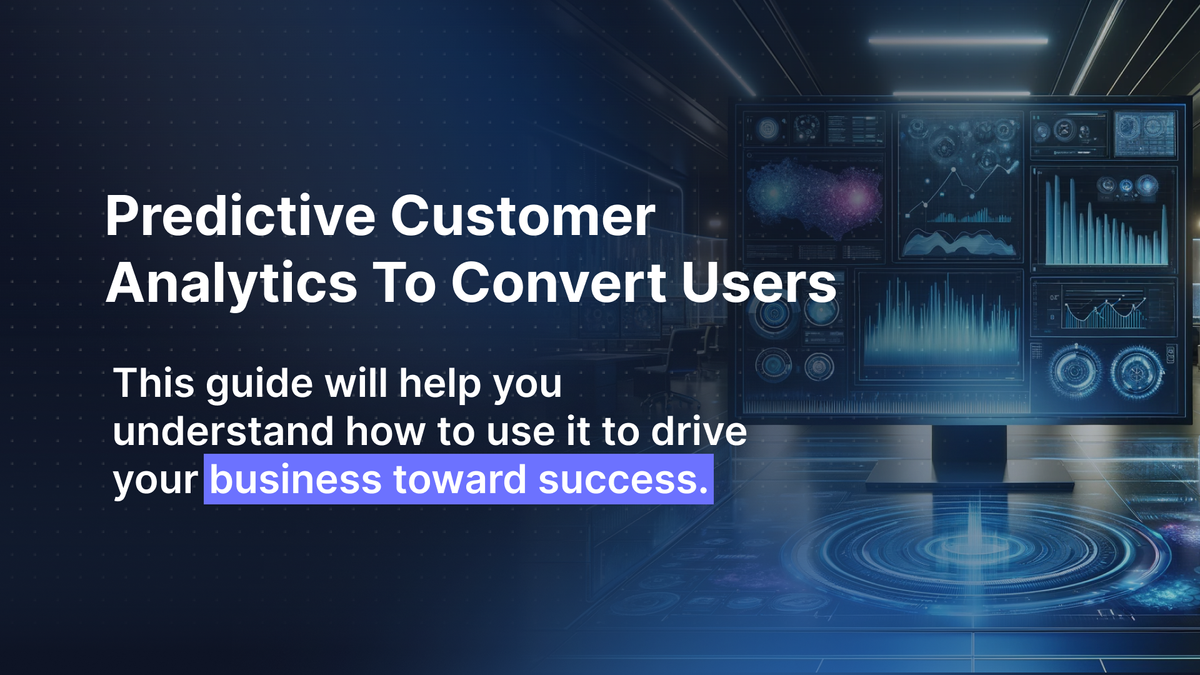Predictive analytics is the key to predicting future outcomes. This guide wil...

Every business relies on customers, and customer retention is an art. While traditional methods can still attract and retain customers, you can achieve results up to 10 times better with advanced technologies and strategies. One such strategy is predictive customer analytics, which is in its boom time.
The market for predictive analytics software is expected to grow to 41.52 billion US dollars by 2028, which was valued at 5.29 billion US dollars in 2020. This trend clearly shows that predictive analytics help businesses become successful by taking a more strategic approach to marketing, customer retention, and product pricing.
Unfortunately, not many people are aware of the correct usage of predictive customer analytics to convert users. That's why we are here with a complete guide that can help you understand what customer analytics is, its pros and cons, and how it can be used for customer support.
Predictive customer analytics uses data, machine learning techniques, statistical algorithms, data mining, artificial intelligence, and other modeling techniques to predict future outcomes. The prediction is completely based on historical data.
The use of predictive analytics has become a growing trend due to the rise of AI and advancement in technology in general. Machine learning can now analyze large data sets quickly and efficiently. That said, it's easier for businesses to derive insights in real time.
The goal is to use this model to understand future customer behavior and sales trends, meet customer expectations, and optimize marketing campaigns. All of this results in better user conversion.
Predictive customer analytics provide a better understanding of customers' personalities. Analysis of current and historical data helps predict future outcomes. Customer analytics has a few other advantages as well.
Instead of relying on uneducated guesses and instincts, organizations can now apply predictive analytics to base their decisions on data. This helps them plan and strategize future marketing campaigns.
Predictive analytics can help understand which platforms best target customers so a business can invest its money more wisely. It also helps optimize inventory levels by preventing overstocking of items that are not needed.
With predictive customer analytics, we can predict the behavior of potential customers who have not yet converted. We can do this by comparing their interaction with those of the previous converted customers. And the best part? You can know about all the factors behind each prediction.
While predictive customer analytics comes with so many benefits, it has an equal number of cons. Let us have a look at the cons in detail:
Sometimes, predictive data analytics rely too much on the training data, capturing not just the patterns but also random fluctuations. The model becomes overly specific and may result in inaccurate predictions. That's why a balance is needed when making a predictive model to capture meaningful patterns only.
This model predicts sensitive information about people without their knowledge and sometimes against their will. To tackle this, there is a concept of predictive privacy that formulates ethical principles for protecting people against differential treatment by Machine Learning.
Predictive customer analytics depends on historical data that can become outdated when market dynamics, customer behavior, and other factors change. However, regular updates in the model can help solve this problem.
While many people struggle to use predictive customer analytics for user conversion, you can use the following four ways to make the most out of it.
Predictive analytics help understand the customers' journey on a deeper level. This information can be used to develop compelling content with certain kinds of messaging. The data from predictive analytics can help you understand the type of content your audience likes and that is more likely to lead to conversions.
For instance, if coupons, free trials, and discounted pricing are the strategies that are converting the targeted audience, you can develop more such offers to increase the conversion rate.
According to McKinsey & Company, 71% of customers expect personalization from a brand. It is also a key factor in customer loyalty and retention. AI-driven personalization in push notifications is the one way to achieve the goal. The other way is to use predictive analytics.
Predictive analysis can help you understand how your marketing sales and demand generation are converting the targeted audience. Having your customers' preference trend data in your hands allows you to take action to meet buyers' needs.
Lead Scoring is about objectively ranking one sales lead against the other. It helps sales managers improve the sales pipeline management and predictions.
Since manual techniques can never be 100% accurate, customer analytics, using historical and current data, can help build a detailed lead profile using AI. It analyzes the insight of your audience and prioritizes the leads as they enter the pipeline.
Let's accept that you can't please all the people. Some individuals can become loyal customers of your brand, while others will not get influenced no matter what. Being able to identify those potential loyal customers can help marketers create targeted strategies that will drive traffic and increase customer retention rates.
The good news is that predictive customer analytics can help identify those groups that are likely to take a genuine interest in your products.
A thorough understanding of predictive customer analytics can help your business implement better plans and strategies. However, this model is complex and comes with its fair share of pros and cons. Getting it right is important to ensure the model keeps up with changing customer behaviors and marketing dynamics.
AI chatbots can further personalize customer service by analyzing customer data such as browsing behavior and purchase history. When the responses are tailored with AI support according to the customer behavior, it always results in a better customer experience.